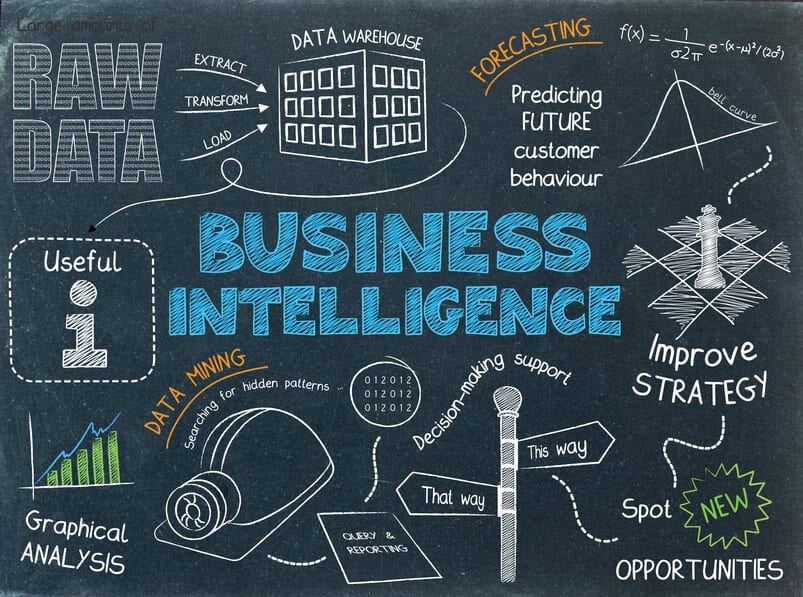
In the first part of this discussion, we covered some emerging and prevalent Business Intelligence trends that will help enterprises gather, warehouse, govern, analyze and secure ever-increasing data volumes. As more data converges from more connected devices within and beyond the workplace, IT teams will need more from their BI tools. The discussion below substantiates how this data-fueled marketplace will collate relevant data from many undefined and disparate resources too, helping businesses create a better managed, unified IT platform. We are talking about real-time data that does not need to cool its heels, waiting for an analyst. This self-servicing data model is at the core of emerging BI trends explained here…
-
BI to be a potent tool in the hands of your SALES team
Right from identifying gaps in sales approach to providing a wealth of information about prospective consumer dynamic, BI is fast becoming a potent tool in the arsenal of sales teams. The emerging BI model can make marketing initiatives more profitable, outreach campaigns more structured and brand communication more productive. Organizations are looking for Business Intelligence Solutions flexible enough to match the existing sales structure while allowing scope for faster scalability for quicker development-to-market models. BI tools ensure that end users are not overwhelmed by silos of information. Instead, they get readily usable, only relevant analyzed data. Whether a brand is aiming for gaining regional or global presence, is in the seed funding state, or is targeting a very specific consumer or regional domain; marketers will increasingly depend on BI-filtered data. An effective sales-based BI system also empowers the marketers to get closer to their existing customers by identifying opportunities that have been missed due to data processing latencies. This means filling the sales pipeline with more convertible leads—a direct incentive to raise your bottom line.
Understanding this with an example: One of our Cloud Computing clients deals in food products and recently introduced a chocolate syrup that is used to layer ice-creams. However, there were certain retail outlets in their targeted area that were not buying the syrup. Our client wanted a precise ‘Gap Analysis’ for identifying why their product did not make sense for these outlets. Based upon analyzed data, their marketing team created a direct mail campaign. A hyper-selective digital campaign was launched to create more points of engagement for this challenging pool of retailers. Our client did not depend upon conventional spreadsheets or documents to create and communicate their research data. Instead, the BI system helped them collate relevant causes for non-sales in real-time, better communication with the retail owners to ensure that the overall perception about their product was corrected. This BI-enabled approach created an unexpected realization—shop owners who were once apprehensive realized that our client can adapt rather quickly to address a market challenge. The word spread across their business partner network and our client got an opportunity to ship its inventory beyond the targeted regions—a huge sales achievement that was not planned!

8. Mobile Analytics attains Individuality as Tech Giants Fuel the BI War
Mobile analytics is no longer considered to be one of the many applications of BI—it has attained an individual presence. We are witnessing an increasing predominance of products that warrant a smooth, mobile-first experience. This trend indicates that working with mobile-enabled data has become a dynamic part of analytics. Tech giants, from Microsoft to Amazon and IBM, are trying to include this as a part of their “unique” offerings. For industry experts, 2016 will witness Mobility Data Analysis to emerge as a core BI offering and not as an add-on service. Amazon has introduced QuickSight while IBM came up with Watson Analytics Service. Similarly, SAP and Oracle are planning to generate more traction in the BI marketplace with revamped offerings that offer mobility solutions as a specialty. Expect a big update from Google for its BI platform BigQuery while speculations are rife that even Apple might enter the fray!
9. CDOs to be Challenged
This year we will see as many CDOs hired as fired. A lot of hype was created around this position when it first came into existence in 2014 & 2015 and the organizations got ‘somebody’ to be held responsible for everything related to data. The ultimate objective of a CDO is democratization of data – holding responsibility for and getting the most relevant insight derived from business data. This is where BI surfaces as an effective tool. But merely employing a BI vendor does not guarantee results. 2016 might witness increasing pressure on Chief Digital Officers with an emphasis on justifying their presence and why BI investments are not yielding expected results. The role of Chief Technology Officers (CTOs) and CDOs might collide and overlap—we need to wait and watch how these hierarchies challenge and redefine themselves.
10. Scalability might become the biggest Parameter for Evaluating BI Platforms
Let us start with System Scalability—you need to make your IT setup scalable enough to support changing user count, incorporating or eliminating different resources and collating increasing volumes of data generated from more data resources. A scalable system upgrades without significant downtimes and delivers without crashing. At the other end of scalability spectrum is Adoption Scalability, which implies the ease with which a system can engage end users and make help them adopt it without any discrepancy. Cloud-based analytics has played a major role in changing the cost-return curve of scalability. A preferred part of contemporary BI models, it renders the necessary amount of computing power to an organization that can be later utilized without a significant investment. Both types of scalability capacities will eventually converge on a single platform, becoming the biggest parameter to evaluate a BI offering. However, this degree of scalability is not easy to achieve—it might become the next major challenge in the BI ecosystem as Big Data blooms and IoT gains momentum in 2016. Obviously, Analytical Scalability is an integral part of this equation. The most common problems encountered when dealing with analytic scalability is representing data in the most useful manner. This is why Visual Analytics is fast gaining prominence as it enables faster spotting of patterns. It expedites analytics, helping businesses forecast emerging challenges and opportunities.
Concluding Thoughts…
The past few months have witnessed a flux in the Business Intelligence landscape with Cloud Services, Data Science, Big Data and Predictive Analytics constantly challenging decision-makers. For making data more usable towards quantifiable outcomes, we suggest cloud-enabled analytics in combination with more versatile technologies. A major shift towards self-service analytics data is underway and this trend too should prevail in 2016. Expect a multi-layer shift from IT-led analytics to a faster, more agile and easy-to-use BI&A platform capable of creating serious business values. As businesses realize the worth of insights derived from diverse data sources, more SMBs and mid-sized corporations too will adopt BI tools, no longer relying on unending rolls of spreadsheets. Also, we are anticipating analytics on Hadoop to become a reality.
